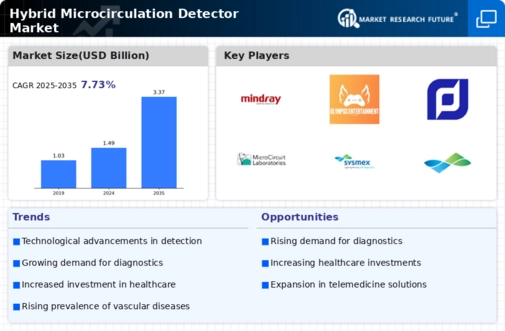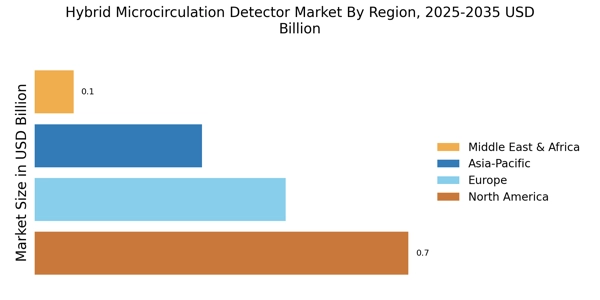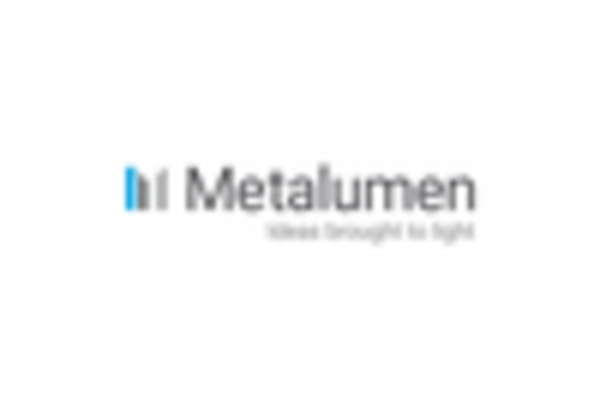Rising Prevalence of Chronic Diseases
The increasing incidence of chronic diseases such as diabetes, cardiovascular disorders, and obesity is driving the demand for advanced diagnostic tools, including those in the Hybrid Microcirculation Detector Market. As healthcare providers seek to monitor microcirculation effectively, the need for hybrid detectors becomes more pronounced. According to recent data, chronic diseases account for a significant portion of healthcare expenditures, prompting investments in innovative technologies. The Hybrid Microcirculation Detector Market is poised to benefit from this trend, as these devices offer enhanced capabilities for early detection and management of chronic conditions, potentially improving patient outcomes and reducing long-term healthcare costs.
Expansion of Healthcare Infrastructure
The expansion of healthcare infrastructure, particularly in emerging markets, is a crucial driver for the Hybrid Microcirculation Detector Market. As healthcare facilities grow and modernize, there is an increasing demand for advanced diagnostic tools to support improved patient care. Investments in healthcare infrastructure are being made to enhance service delivery and accessibility, which in turn drives the need for hybrid microcirculation detectors. Data indicates that healthcare spending in emerging markets is projected to rise significantly, creating a favorable environment for the Hybrid Microcirculation Detector Market. This expansion not only increases the availability of these devices but also promotes awareness and adoption among healthcare providers.
Increased Focus on Research and Development
The emphasis on research and development within the healthcare sector is significantly impacting the Hybrid Microcirculation Detector Market. As researchers explore the complexities of microcirculation and its implications for various health conditions, there is a growing need for advanced detection technologies. Funding for R&D in medical technologies has seen a substantial increase, with many institutions prioritizing projects that aim to improve diagnostic capabilities. This trend is likely to foster innovation within the Hybrid Microcirculation Detector Market, as new findings and technologies emerge, leading to the development of more sophisticated and effective detection devices.
Technological Innovations in Medical Devices
Technological advancements in medical devices are a key driver for the Hybrid Microcirculation Detector Market. Innovations such as improved imaging techniques, enhanced sensor technologies, and integration with digital health platforms are transforming the landscape of microcirculation assessment. The market is witnessing a surge in the development of hybrid detectors that combine multiple technologies to provide comprehensive insights into microcirculation. Data suggests that the medical device sector is expected to grow at a compound annual growth rate of over 5% in the coming years, indicating a robust environment for the Hybrid Microcirculation Detector Market. These innovations not only enhance diagnostic accuracy but also facilitate better treatment planning and monitoring.
Growing Demand for Non-Invasive Diagnostic Tools
There is a notable shift towards non-invasive diagnostic methods in the healthcare sector, which is significantly influencing the Hybrid Microcirculation Detector Market. Patients and healthcare professionals alike prefer non-invasive techniques due to their comfort and reduced risk of complications. This trend is supported by data indicating that non-invasive procedures are associated with higher patient satisfaction rates. As a result, manufacturers are increasingly focusing on developing hybrid microcirculation detectors that provide accurate readings without the need for invasive procedures. This growing demand is likely to propel the Hybrid Microcirculation Detector Market forward, as these devices align with the evolving preferences of both patients and healthcare providers.

















Leave a Comment